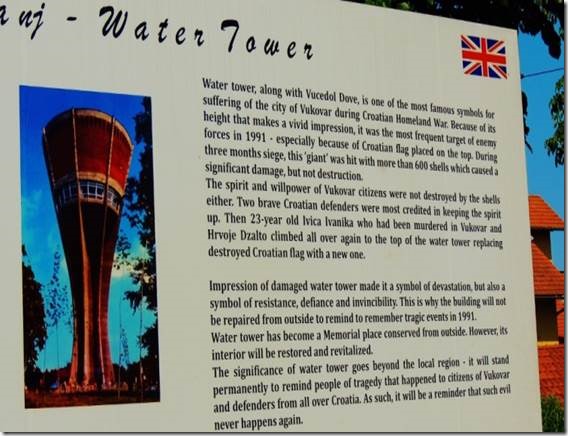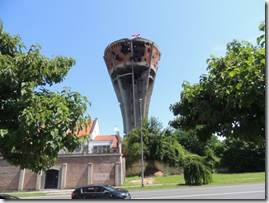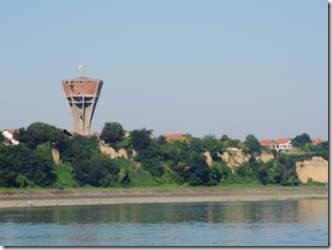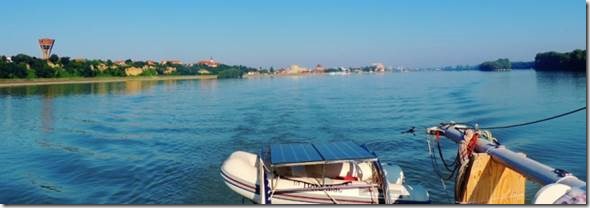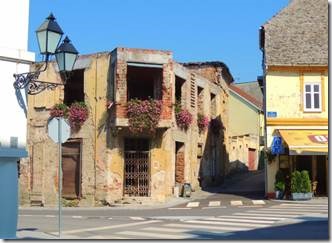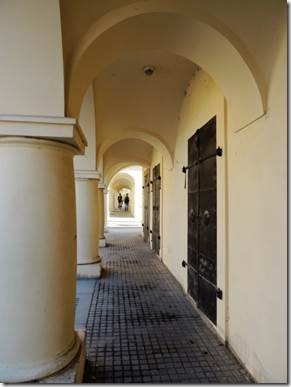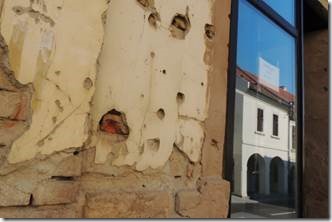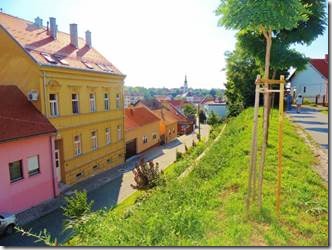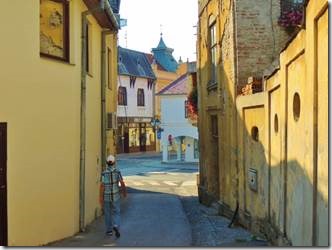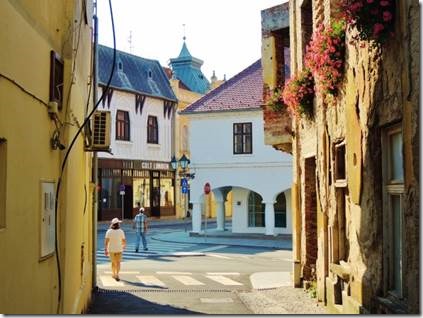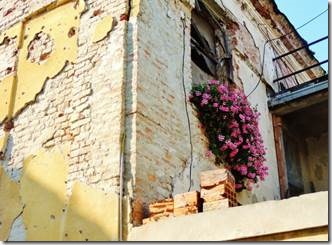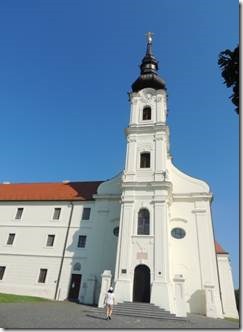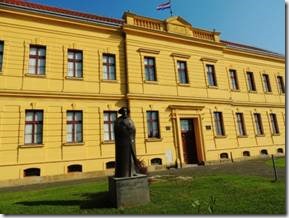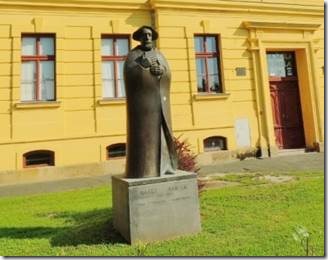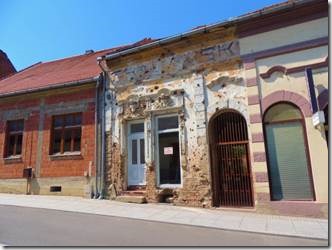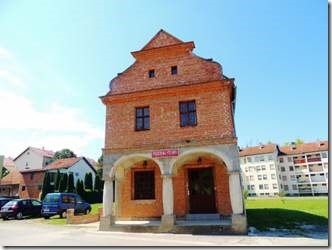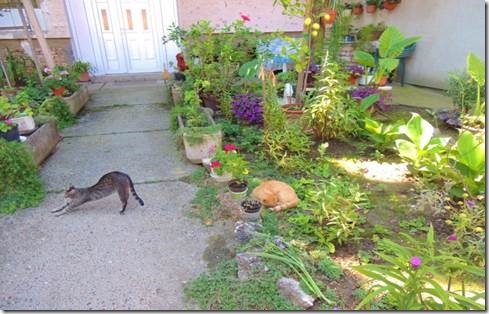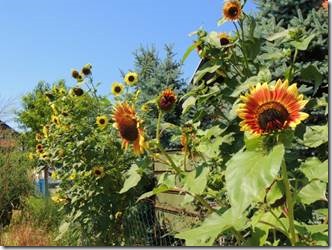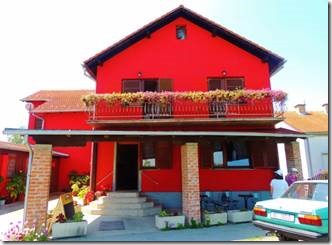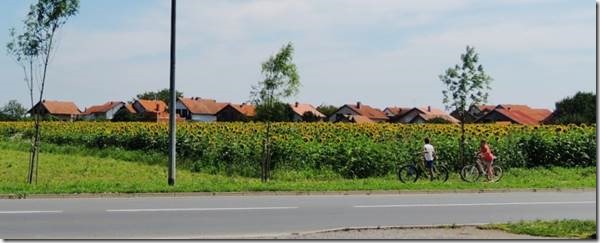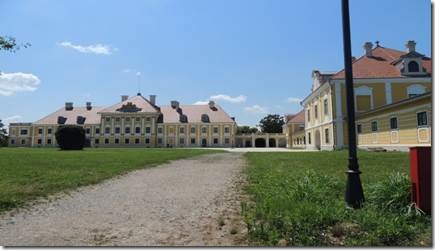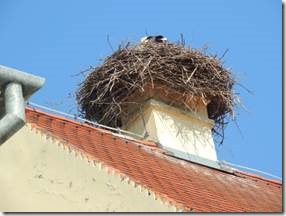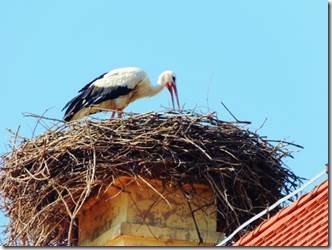Porecka Reka
Anchoring for the night.
The Porečka reka is a river in eastern Serbia, a 50 km-long right tributary to the Danube in the Đerdap gorge. It originates from two headstreams, the Šaška and the Crnajka rivers, which meet at the village of Miloševa Kula. Wikipedia
This is the first time we’re anchoring during this river trip. Usually there’s someplace to tie up, but, apparently the further east we go, the less developed boat services. So we’ll see. Amazingly Rick’s super antenna has tracked down some wifi. Last night in the town of Smederevo we had no wifi. We were blasted with disco music from evening to dawn to make up for the wifi lack. As we had to cover 130 kilometers today, 5 am was wake up time and we were off by 5:15. We had hours of rain and thunder and lightning but then it cleared and tonight is bright and sunny. Rain is forecasted for the next 7 days; but up until now we’ve had great weather so one really can’t complain.
This is Vukovar part 2. The more I read about the breakup of Yugoslavia and the conflicts that followed the less I think I know. Rather than pass along incorrect information, I let you read and try to understand yourselves.
Ru
http://www.tzvsz.hr/en/ tourist site
“The port of Vukovar serves as a gateway for excursions into Croatia’s fertile rural region west of the Danube. Visible from the river, the bullet-ridden water tower makes a sad landmark. The capital of the Srijem region, with its churches, patrician houses and arcaded passages near the baroque castle of the counts of Eltz, was once regarded as a jewel of urban baroque architecture. In 1991, it fell victim to the civil war in former Yugoslavia. After Serbian-occupied eastern Slavonia was restored to Croatia in 1998, reconstruction began in earnest. Restored historical edifices as well as modern buildings now offer hope for a renaissance of the most important Croatian port town on the Danube.” JPM Danube Guide
The Breakup of Yugoslavia, 1990–1992 Office of the Historian https://history.state.gov/milestones/1989-1992/breakup-yugoslavia explains far better than I could why the battles took place between Croatia and Serbia while both were part of Yugoslavia.
|
23 June 2011 Croatia Vukovar war: Overcoming a legacy of war By Allan Little Three months of siege and bombardment by Serb forces in 1991 all but reduced the town to rubble – and destroyed a once happy, common life lived by Serbs, Croats and more than 20 other registered national minorities alike. Today the ethnic groups walk the same streets but they do so separately. http://www.bbc.com/news/world-europe-13887103 Symbol of the conflict “The Vukovar water tower in the eastern Croatian city of Vukovar is one of the most famous symbols in Croatia of the suffering of the city and the county in the Battle of Vukovar and the Croatian War of Independence, when the water tower and the city itself were largely destroyed by the Serb forces. Now, for the first time, photographs from inside the tower have been published. Until the war, the top of the tower was home to a restaurant with a view over Vukovar, Dunav and surrounding vineyards. During the Serbian attack on Vukovar, the water tower, which was built-in the 1960′s, was one of the most frequent targets of enemy artillery. It was hit more than 600 times during the siege. The water tower will not be renovated but will be left in its current state to serve as a reminder of the suffering the city endured. http://www.croatiaweek.com/ Croatia on one side of the Danube and Serbia on the other. You can see the remains of the water tower restaurant in Vukovar taken the morning we left as we continue on down the Danube towards Novi Sad in Serbia. http://www.croatia.org/ tells not only about the conflict, but shows photos of the destruction, talks about the massacre and the new rebuilt Vukovar. It even shows some photos of the public library. This is obviously from the Croatian point of view. |
|
You can’t help but to think about the bombing of and attack on Vukovar by Serbia because so many buildings bear the scars of the conflict. Among the rebuilt homes and business are the ruins of buildings, the open spaces where buildings once stood. We also ruins in Belgrade from the NATO bombing |
|
The steeple on the church of Church of Sts. Philip and James was totally destroyed during the bombing. “…the Franciscan friary with the Church of Sts. Philip and James and the High School. The construction of the friary and the church started on 24 June 1723 and continued throughout the 18th century. Until the devastation caused by the war, which did not spare the rich Franciscan heritage, including the old friary library with its 17000 volumes, the friary with the Church of Sts. Philip and James was the oldest preserved Baroque monument and the oldest building in Vukovar. The church and the friary are protected cultural monuments. The Vukovar High School was founded in 1891.” |
|
Vukovar High School founded in 1891 “Marko Marulić, (born August 18, 1450, Split, Dalmatia [now in Croatia]—died January 6, 1524, Split), Croatian moral philosopher and poet whose vernacular verse marked the beginnings of a distinctive Croatian literature. The scion of a noble family, Marulić studied classical languages and literature and philosophy at Padua [Italy] before returning to his native Split and a life of public service, scholarship, and writing. At age 60 he withdrew to a Franciscan monastery on the island of Šolta, but he returned to Split, disillusioned by the experience, two years later. Marulić’s didactic moral works were written in Latin and translated into many European languages. They stressed practical Christianity and reflected an appreciation of Stoic thought. His most important vernacular poem was Istoria sfete udovice Judit u versih harvacchi slozena (written 1501 and published in 1521; “The History of the Holy Widow Judith Composed in Croatian Verses”). The first printed Croatian literary work, Judita is an epic in six cantos in which Marulić sought by the example of a Hebrew heroine to encourage his people in their struggles against the Turks. Elevating as it does vernacular Croatian to the status of a literary language and uniting Marulić’s classical and Italian literary education with Croatian poetic traditions, this work proved a springboard for the nascent Croatian literature.” http://www.britannica.com/EBchecked/topic/367199/Marko-Marulic |
|
This building is on the main road not far from the water tower. “Vukovar nocturne Vukovar nocturne is a faithful reflection of what was experienced. It is a story of love and courage, strength and pain, human dignity and victory of life. The story of a tragedy of a nation, on victims, heroes, defiance and pride was passed on to Vukovar nocturne which joins all places in town that bear the remembrance of the Homeland war.” Now a photographer’s studio; but what is its history and what once stood near it? |
|
The elderly home owner wouldn’t let me take her photo but was happy to have to let me photograph her cats and garden. They reminded me of my pal Sheila’s first cats Buffy and Lori. Sunflowers grew in gardens and empty lots |
|
Our lunch stop during a Saturday afternoon walk. The plan was to walk to the park/cemetery and stop for lunch on the way back. Thomas had recommended this café as it was midway. But it was really hot by 11:30 so when we got here we just stopped for a cold drink and early lunch. After lunch Randal and Mary voted to return to town rather than continue on to the cemetery. It would have been almost 7 miles for the entire walk with little shade on the route so not the best day for a long hike. Across from the restaurant was a huge field of sunflowers stretching out of the photo on both sides. Behind the fields looked to be a development of new homes with more under construction. |
|
We decided to visit the Eltz Castle but by the time we arrived it had closed for the day. Saturday was an “early closing” day in town. “The City Museum Vukovar was founded in 1946 and the first permanent exhibition was opened in 1948…. During the Croatian War of Independence in 1991 the complex of the Eltz Castle suffered heavy devastation and continued its activities as the Museum in exile till returning to the devastated Eltz Castle, in which the reconstruction process began in 2005. The construction works on the complex were finished in November 2011. Eltz – a real person. “10 Apr 2006 Jakob Eltz, who died on February 10 aged 84, represented a link between modern Europe and the Habsburg Empire; in the 1990s he played an important part in the establishment of Croatia as an independent democratic state. “ http://www.telegraph.co.uk/ is the obit for Jakob Eltz |
|
Vukovar Town Stork I first saw stork nests in Turkey and was amazed by them. This nest was in the town center. Apparently storks return to the same next year after year. The story below isn’t about Vukovar, but it is a lovely story about storks in a different Croatian town. Mar 24, 2014 A local called Stjepan Vokic has promised to keep her safe, and has served as her guardian for the last two decades. Every year, he would anxiously expect Klepetan’s return, hoping that the bird succeed in avoiding the perils of such a long trip. Today at 5:00 a.m. Klepetan returned for the twelfth time in a row. The date corresponds with the last year’s arrival. Hungry and tired, but with much love in his eyes, he greeted the welcoming Malena. This love game usually means another round of chicks is to be expected later in the year. With Stjepan’s help, the pair raised over 40 small birds so far. http://www.likecroatia.com/news-tips/klepetan-back-needs-help/ Croatian storks Rodan and Malena reunited after 8,000 mile winter flight Tuesday 30 Mar 2010 http://metro.co.uk/ talks about the 5th year in 2010 Though storks form monogamous pairs for the duration of the breeding season, they do not migrate or over-winter together. If the same pair reforms in successive years it is largely due to their strong attachment to their nest site. The legend that the European White Stork brings babies is believed to have originated in northern Germany, perhaps because storks arrive on their breeding grounds nine months after midsummer. Northern Europeans of Teutonic ancestry encouraged storks to nest on their homes hoping they would bring fertility and prosperity. This tradition of welcome and protection did not exist in the portions of France where the White Stork disappeared first. The oldest recorded lifespan in the wild is 25 years, captive individuals may live up to 48 years. Mortality after the second year of life has been estimated at 21%, before 2 years of age it may be 30% or higher. (Cramp, et al., 1977) http://animaldiversity.ummz.umich.edu/accounts/Ciconia_ciconia/ |

